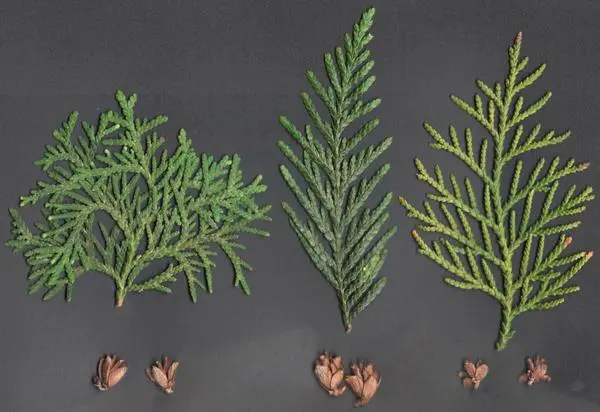Contents
Thuja and juniper are evergreen conifers with beneficial properties. If they are planted in the garden, they will purify the air of bacteria with their phytoncides, fill the space with a charming aroma. But many gardeners do not understand these plants, so the article will show the differences between thuja and juniper.
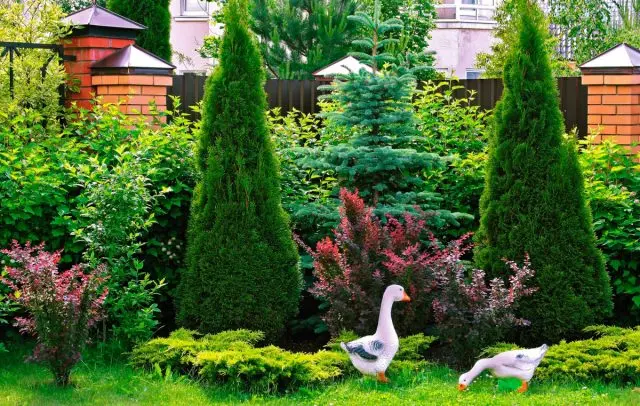
What is the difference between juniper and thuja
Both thuja and juniper are representatives of the same Cypress family, which explains their external similarity. These are the oldest plants that appeared on earth and have survived to this day. In one place, unpretentious plants with proper care can grow for centuries. That is why designers paid attention to these conifers.
Thuja and juniper actually have some similarities, so novice gardeners cannot always tell them apart. Both evergreens have similar scaly needles that have nothing to do with ordinary coniferous trees and shrubs.
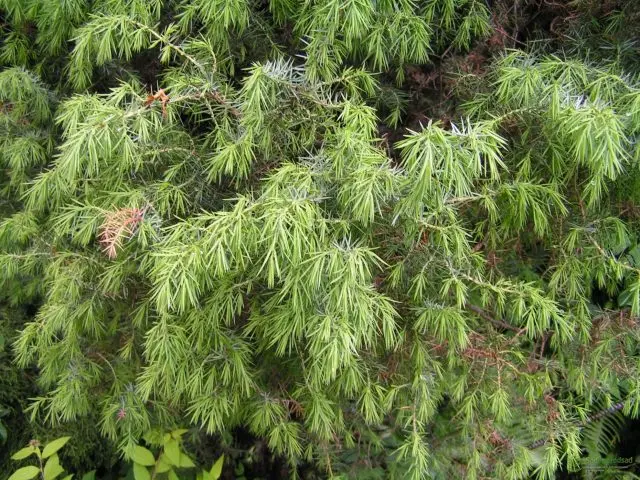
If you look closely at the modified leaves, you can see the difference. Juniper needles throughout life remain in the form of needles. And the thuja needles are gradually changing, becoming scaly.
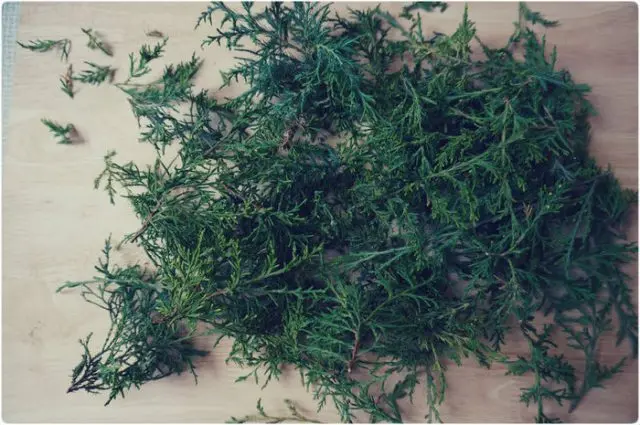
Looking at the crown, it is also difficult to immediately figure out where the thuja is and where the juniper is. Due to pruning, they are pyramidal, columnar or in the form of balls. There are varieties of both types of conifers that can be grown not only in the garden, but also in the apartment.
What is the difference between thuja and juniper
To understand which plant to choose for the garden, you need to learn how to distinguish thuja from juniper according to biological characteristics. We need to talk about them in more detail.
Thuya
Thuja belongs to tree-like plants, it develops very quickly. An adult tree grows up to 6 m, in girth – about 70 cm. In garden plots, thuja is grown in the form of a pyramid or shrub, in which the branches are located in the same plane. The shape of the tree depends on the variety chosen. Despite the high frost resistance, no one has yet managed to grow thuja in the Far North in open ground.
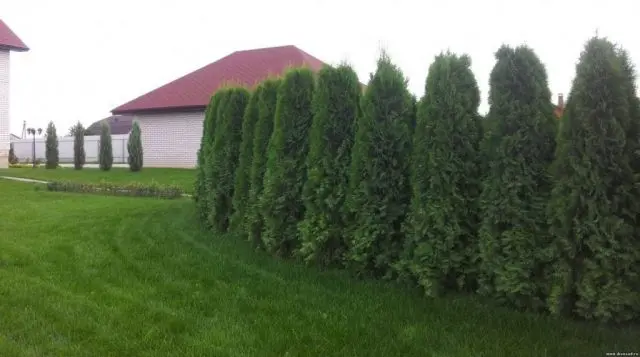
Thuja can be distinguished by a gray smooth trunk. The bark of an old tree changes. Longitudinal fibers appear on it, which exfoliate in the form of narrow ribbons.
Needles with small scales are tightly pressed against each other. The branches of the thuja are short, cones 7-12 cm long are formed on them. As a rule, there are 2 seeds in each of them.

All parts of the plant are useful:
- Thuja needles are rich in resins, essential oils, tannins and flavonoids.
- Seeds are a storehouse of essential oils.
- Tui wood contains toxifylline, aromadendrin.
Medicinal and homeopathic preparations are prepared from thuja:
- Representatives of oriental medicine have long used parts of the thuja for treatment.
- Healers in Our Country healed people from cystitis, prostate, rheumatic pains, urinary incontinence.
- With the help of medicines prepared from thuja, you can get rid of worms, papillomas, warts.
- Lubrication with folk remedies based on thuja promotes the resorption of postoperative scars, whitens the skin, and saves it from inflammatory processes.
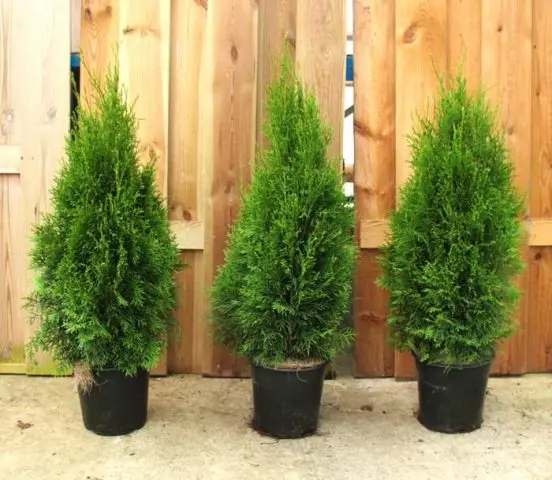
Juniper
The height of an adult juniper is greater than the thuja – this is also one of the differences. Usually junipers grow up to 7-8 m, and sometimes up to 15 m, depending on the variety. There are also undersized creeping shrubs. They are used as ground cover plants for landscaping the site.

The juniper has a trunk with a large number of branches, on which sharp and hard needles are located. Each ring contains 3 modified leaves.
In spring, dioecious flowers appear on the plant:
- male inflorescences are shaped like earrings;
- female are represented by round cones.
The flowering of juniper begins in May, and the fruits appear only the next year, late in the fall. These are small berries, the surface of which is covered with a bluish bloom. Each berry usually contains 3 seeds.
Under natural conditions, junipers can be found in forests, on mountains, in floodplains and in swamps. This plant has been used in gardens since ancient times due to its beneficial properties. The ancient Greeks and Egyptians were the first to be treated with juniper-based products.
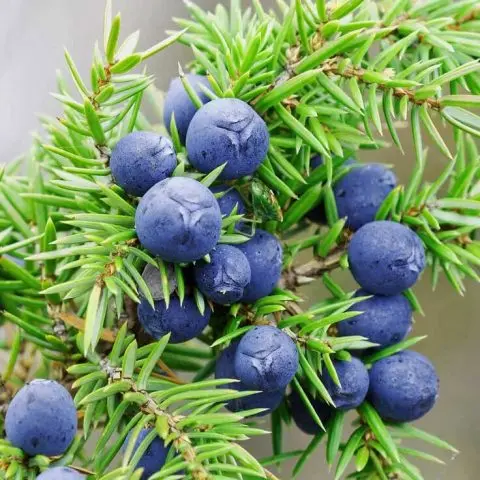
Today, medicines are prepared from juniper berries. In the pharmacy you can always buy juniper essential oil. Folk healers heal their patients with decoctions, tinctures, syrups. There is no such field of medicine in which the juniper berry would not give an effect. The fruits are widely used by culinary specialists as a spice for making vodka and liquor.
What is useful juniper:
- The fruits contain various sugars (40%), resins (10%), essential oils (2%). According to the content of acids (formic, acetic, malic), as well as vitamin C, camphor, juniper fruits are many times superior to other berries.
- The needles contain ascorbic and rhodisonic acid. It is due to them that the bactericidal effect is ensured. The essential oils of this conifer are more powerful than other trees.
How to distinguish thuja from juniper
- Juniper ordinary.

- Thuja.

To choose thuja or juniper seedlings and not make a mistake, you need to learn to distinguish plants visually:
- Firstly, conifers have different needles.
- Secondly, they differ in size and height.
- Thirdly, you need to learn to distinguish plants by cones. Thuja is characterized by oval or oblong cones, on which there are 2 or 6 pairs of scales. And in juniper, the fruit is called a cone-berry. They are spherical in shape, inside which there are 1-10 seeds (depending on the type).
- Fourthly, plants differ in height and shape: both species can be represented by trees or shrubs.
Use in landscape design
Having learned to distinguish between thuja and juniper in appearance and biological characteristics, the gardener himself decides whether to plant these trees on the site. If a positive decision is made, you need to understand the features of the landscape use of coniferous plants. Both thuja and juniper are able to ennoble the site, give it an unusual look. But for this you need to understand the rules for the use of evergreen conifers in the design of a summer cottage.
Juniper Uses
Junipers can be planted singly, as tapeworms, or planted in groups at specific spacings. These plants can be included in various compositions with deciduous and coniferous trees, with flowering wild plants.
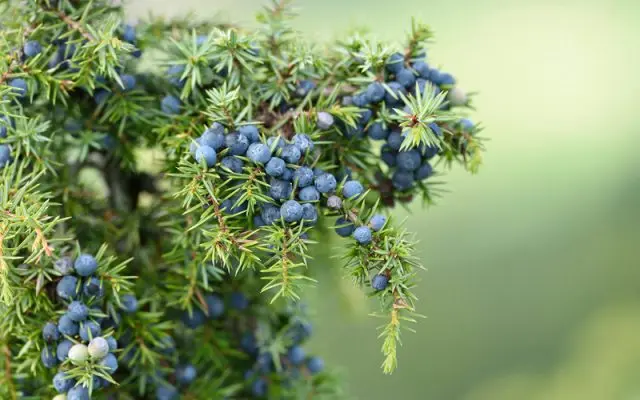
Experienced gardeners advise growing these conifers in threes, in the form of a triangle. In the lower tier, creeping varieties of junipers can be planted with pyramidal plants.
Trees look great on alpine slides and in rockeries. But as a hedge, juniper plants are practically not used, since junipers grow relatively slowly.
If the site has sliding slopes or slopes, plants can be planted on them to strengthen the soil.
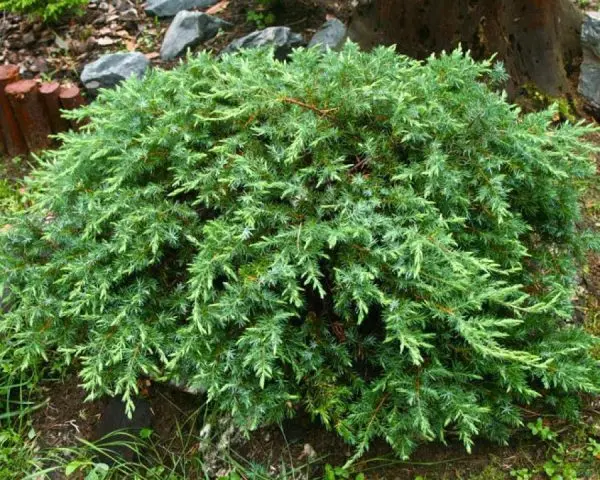
There are many types of juniper that grows horizontally. They are used as ground cover plants.
Thuja in landscape design
Thuyu, like juniper, has long been used by landscape designers. These evergreens will enliven any garden, not only in summer, but also in winter. With its help, you can create mini-parks (nature gardens), plant trees or shrubs separately.
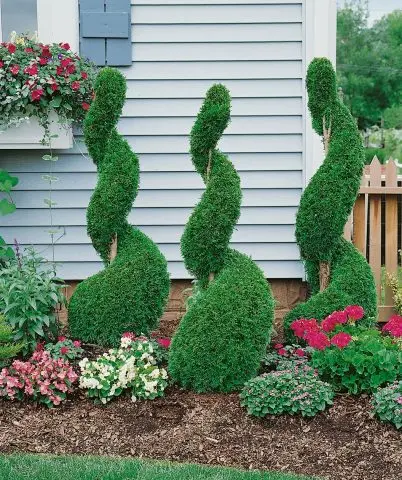
Tall thujas adorn landscaped terraces. Dwarf varieties look great in flower beds, rockeries and alpine slides. These conifers are able to withstand low temperatures, so they can be grown in harsh climatic conditions.
Shrub arborvitae are great for creating hedges. For this purpose, the following varieties are most often used:
- Brabant;
- Emerald;
- Column.
Tui become a real decoration after a haircut. The crown can be given various shapes, cut out animal figures.
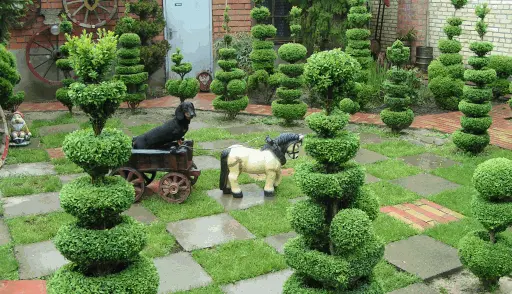
Peculiarities of growing
Tui and junipers are unpretentious plants that are successfully grown in almost all regions of Our Country. The agricultural technology of these conifers is largely similar, although there are some differences.
juniper care
Junipers can be planted both in sunny places and in light shading. To preserve the beautiful crown and color of the needles, the plant must be looked after, following the rules.
The end of winter and the beginning of autumn can cause sunburn. It’s all about the activity of the luminary. So that the needles do not burn out, during these periods you need to take care of shading. You can throw burlap or install screens.
Watering
Newly planted young junipers should be watered regularly and abundantly, preventing the topsoil from drying out. After all, the roots are located close to the surface.
Those trees that are already well rooted, as well as mature plants, do not need watering if the season is rainy. In dry and hot summers, 1-3 buckets of water are poured under each plant (depending on the age of the conifer). So that the needles do not dry out, it is necessary to carry out sprinkling.
Additional fertilizing
With regards to dressings, juniper plantings do not particularly need them. You should never give organic. At first, only young trees are fed at the beginning of the growing season with nitroammophos, potassium nitrate or other complex fertilizer intended for coniferous plants.
Trimming
Unlike many garden plants, junipers do not need to be pruned. Although there are varieties, for example, Skyrocket, which without this procedure look untidy, shaggy. This culture needs to be sheared to give a certain shape.
In early spring and late autumn, the tree must be cleaned, damaged and dry branches removed.
Protection against diseases and pests
Juniper practically does not get sick with anything, on the contrary, due to its smell, it is able to scare away pests from other garden crops.
But it is not always possible to secure landings from fungal diseases. That is why it is necessary to carry out preventive treatments of juniper with special fungicidal preparations, for example, Topsin-M.
Tui care
Caring for a thuja is easy. After all, the plant is unpretentious. All activities for the care of thuja come down to watering, feeding, protection from diseases and pests.
Watering rules
Thuja is demanding on irrigation, it must be regularly watered under the root and sprinkled to wash off the dust and protect the needles from burning out. Plan an event for the morning or evening. After watering, you need to remove weeds and loosen the soil.
How to feed
The first feeding of thuja is carried out six months after planting seedlings. To do this, use ammonium nitrate, urea or special fertilizers for conifers.
Trimming
Thuja needs formative (autumn) and sanitary (early spring, before sap flow) pruning. In addition, you need to remove dried branches and needles inside the crown so that the tree can breathe.
For the winter, both thuja and juniper need to be wrapped with a rope, as in the photo.
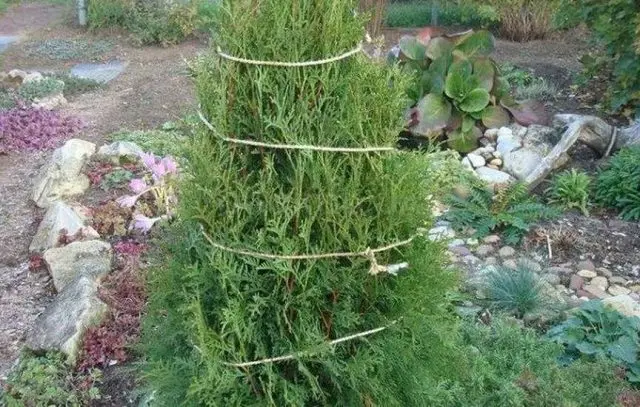
Which is better to choose
Thuja and juniper look great on any site. The main thing is to choose the right place and observe the features of agricultural technology.
Conclusion
Knowing the differences between thuja and juniper, the rules for their cultivation, you can create a unique landscape design. Which plant to choose depends on the preferences of the owners. You should also know that beautiful topiaries can be created from thuja plantings.











